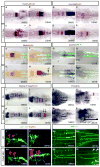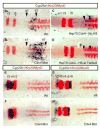CDX4 and retinoic acid interact to position the hindbrain-spinal cord transition
- PMID: 26773000
- PMCID: PMC4781753
- DOI: 10.1016/j.ydbio.2015.12.025
CDX4 and retinoic acid interact to position the hindbrain-spinal cord transition
Abstract
The sub-division of the posterior-most territory of the neural plate results in the formation of two distinct neural structures, the hindbrain and the spinal cord. Although many of the molecular signals regulating the development of these individual structures have been elucidated, the mechanisms involved in delineating the boundary between the hindbrain and spinal cord remain elusive. Two molecules, retinoic acid (RA) and the Cdx4 transcription factor have been previously implicated as important regulators of hindbrain and spinal cord development, respectively. Here, we provide evidence that suggests multiple regulatory interactions occur between RA signaling and the Cdx4 transcription factor to establish the anterior-posterior (AP) position of the transition between the hindbrain and spinal cord. Using chemical inhibitors to alter RA concentrations and morpholinos to knock-down Cdx4 function in zebrafish, we show that Cdx4 acts to prevent RA degradation in the presumptive spinal cord domain by suppressing expression of the RA degradation enzyme, Cyp26a1. In the hindbrain, RA signaling modulates its own concentration by activating the expression of cyp26a1 and inhibiting the expansion of cdx4. Therefore, interactions between Cyp26a1 and Cdx4 modulate RA levels along the AP axis to segregate the posterior neural plate into the hindbrain and spinal cord territories.
Keywords: Cdx; Hindbrain; Hox genes; Retinoic acid; Spinal cord.
Copyright © 2016 Elsevier Inc. All rights reserved.
Figures






Similar articles
-
Cdx-Hox code controls competence for responding to Fgfs and retinoic acid in zebrafish neural tissue.Development. 2006 Dec;133(23):4709-19. doi: 10.1242/dev.02660. Epub 2006 Nov 1. Development. 2006. PMID: 17079270
-
Retinoic acid-metabolizing enzyme Cyp26a1 is essential for determining territories of hindbrain and spinal cord in zebrafish.Dev Biol. 2005 Feb 15;278(2):415-27. doi: 10.1016/j.ydbio.2004.11.023. Dev Biol. 2005. PMID: 15680360
-
Retinoic acid regulates size, pattern and alignment of tissues at the head-trunk transition.Development. 2014 Nov;141(22):4375-84. doi: 10.1242/dev.109603. Development. 2014. PMID: 25371368
-
Origins of anteroposterior patterning and Hox gene regulation during chordate evolution.Philos Trans R Soc Lond B Biol Sci. 2001 Oct 29;356(1414):1599-613. doi: 10.1098/rstb.2001.0918. Philos Trans R Soc Lond B Biol Sci. 2001. PMID: 11604126 Free PMC article. Review.
-
Retinoic acid and hindbrain patterning.J Neurobiol. 2006 Jun;66(7):705-25. doi: 10.1002/neu.20272. J Neurobiol. 2006. PMID: 16688767 Review.
Cited by
-
scMultiome analysis identifies a single caudal hindbrain compartment in the developing zebrafish nervous system.Neural Dev. 2024 Jul 5;19(1):12. doi: 10.1186/s13064-024-00189-z. Neural Dev. 2024. PMID: 38970093 Free PMC article.
-
Visualizing retinoic acid morphogen gradients.Methods Cell Biol. 2016;133:139-63. doi: 10.1016/bs.mcb.2016.03.003. Epub 2016 Apr 18. Methods Cell Biol. 2016. PMID: 27263412 Free PMC article.
-
Hindbrain and Spinal Cord Contributions to the Cutaneous Sensory Innervation of the Larval Zebrafish Pectoral Fin.Front Neuroanat. 2020 Oct 20;14:581821. doi: 10.3389/fnana.2020.581821. eCollection 2020. Front Neuroanat. 2020. PMID: 33192344 Free PMC article.
-
Hindbrain induction and patterning during early vertebrate development.Cell Mol Life Sci. 2019 Mar;76(5):941-960. doi: 10.1007/s00018-018-2974-x. Epub 2018 Dec 5. Cell Mol Life Sci. 2019. PMID: 30519881 Free PMC article. Review.
-
Early molecular events during retinoic acid induced differentiation of neuromesodermal progenitors.Biol Open. 2016 Dec 15;5(12):1821-1833. doi: 10.1242/bio.020891. Biol Open. 2016. PMID: 27793834 Free PMC article.
References
-
- Begemann G, Schilling TF, Rauch GJ, Geisler R, Ingham PW. The zebrafish neckless mutation reveals a requirement for raldh2 in mesodermal signals that pattern the hindbrain. Development. 2001;128:3081–3094. - PubMed
-
- Béland M, Lohnes D. Chicken ovalbumin upstream promoter-transcription factor members repress retinoic acid-induced Cdx1 expression. J Biol Chem. 2005;14:13858–62. - PubMed
-
- Bel-Vialar S, Itasaki N, Krumlauf R. Initiating Hox gene expression: in the early chick neural tube differential sensitivity to FGF and RA signaling subdivides the HoxB genes in two distinct groups. Development. 2002;129:5103–5115. - PubMed
-
- Carpenter EM, Goddard JM, Chisaka O, Manley NR, Capecchi MR. Loss of Hoxa-1 (Hox-1.6) function results in the reorganization of the murine hindbrain. Development. 1993;118:1063–1075. - PubMed
Publication types
MeSH terms
Substances
Grants and funding
LinkOut - more resources
Full Text Sources
Other Literature Sources
Molecular Biology Databases
Research Materials

